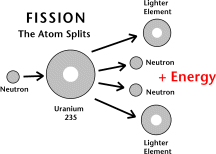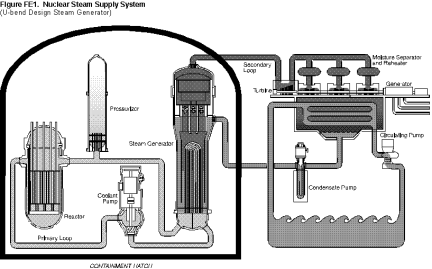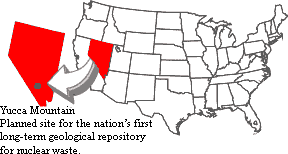|
Nuclear
Energy
See
also:
other
readings with assessment in Alternative Energy -- Wind
Energy -- Geothermal Energy -- Hydropower -- Nuclear Energy
--
see
Alternative Energy Basics
|
|
|
NUCLEAR ENERGY
IS ENERGY FROM ATOMS
Nuclear energy
is energy in the nucleus (core) of an atom. Atoms are tiny particles
that make up every object in the universe. There is enormous energy
in the bonds that hold atoms together.
Nuclear energy can be used to make electricity. But first the energy
must be released. It can be released from atoms in two ways: nuclear
fusion and nuclear fission.
In nuclear fusion,
energy is released when atoms are combined or fused together to
form a larger atom. This is how the sun produces energy when hydrogen
atoms are fused to form helium atoms.
In nuclear fission,
atoms are split apart to form smaller atoms, releasing energy. Nuclear
power plants use nuclear fission to produce electricity.
NUCLEAR FUEL
- URANIUM
The fuel most
widely used by nuclear plants for nuclear fission is uranium. Uranium
is nonrenewable, though it is a common metal found in rocks all
over the world. Nuclear plants use a certain kind of uranium, U-235,
as fuel because its atoms are easily split apart. Though uranium
is quite common, about 100 times more common than silver, U-235
is relatively rare. Most U.S. uranium is mined, in the
Western United States. Once uranium is mined the U-235 must
be extracted and processed before it can be used as a fuel.
 During nuclear fission, a small particle called a neutron
hits the uranium atom and splits it, releasing
a great amount of energy as heat and radiation. More neutrons are
also released. These neutrons go on to bombard other uranium atoms,
and the process repeats itself over and over again. This is called
a chain reaction. During nuclear fission, a small particle called a neutron
hits the uranium atom and splits it, releasing
a great amount of energy as heat and radiation. More neutrons are
also released. These neutrons go on to bombard other uranium atoms,
and the process repeats itself over and over again. This is called
a chain reaction.
NUCLEAR POWER
PLANTS GENERATE ELECTRICITY
Nuclear power
accounts for about 19 percent of the total net electricity generated
in the United States, about as much as the electricity used in California,Texas
and New York, the three states with the most people. In 2006,
there were 66 nuclear power plants (composed of 104 licensed nuclear
reactors) throughout the United States.
Most power plants
burn fuel to produce electricity, but not nuclear power plants.
Instead, nuclear plants use the heat given off during fission as
fuel. Fission takes place inside the reactor of a nuclear power
plant. At the center of the reactor is the core, which contains
the uranium fuel.
The uranium
fuel is formed into ceramic pellets. The pellets are about the size
of your fingertip, but each one produces the same amount of energy
as 150 gallons of oil. These energy-rich pellets are stacked end-to-end
in 12-foot metal fuel rods. A bundle of fuel rods is called a fuel
assembly.
Fission generates
heat in a reactor just as coal generates heat in a boiler. The heat
is used to boil water into steam. The steam turns huge turbine blades.
As they turn, they drive generators that make electricity. Afterward,
the steam is changed back into water and cooled in a separate structure
at the power plant called a cooling tower. The water can be used
again and again.
TYPES OF REACTORS
Just as there
are different approaches to designing and building airplanes and
automobiles, engineers have developed different types of nuclear
power plants. Two types are used in the United States: boiling-water
reactors (BWRs), and pressurized-water reactors (PWRs).
In the BWR,
the water heated by the reactor core turns directly into steam in
the reactor vessel and is then used to power the turbine-generator.
In a PWR, the water passing through the reactor core is kept under
pressure so that it does not turn to steam at all -- it remains
liquid. Steam to drive the turbine is generated in a
separate piece of equipment called a steam generator. A steam
generator is a giant cylinder with thousands of tubes in it through
which the hot radioactive water can flow. Outside the tubes
in the steam generator, nonradioactive water (or clean water)
boils and eventually turns to steam. The clean water may come
from one of several sources: oceans, lakes or rivers. The
radioactive water flows back to the reactor core, where it is reheated,
only to flow back to the steam generator. Roughly seventy
percent of the reactors operating in the US are PWR.
Nuclear reactors
are basically machines that contain and control chain reactions,
while releasing heat at a controlled rate. In electric power
plants, the reactors supply the heat to turn water into steam, which
drives the turbine-generators. The electricity travels through
high voltage transmission lines and low voltage distribution lines
to homes, schools, hospitals, factories, office buildings, rail
systems and other users.

NUCLEAR POWER
AND THE ENVIRONMENT
Compared to
electricity generated by burning fossil fuels, nuclear energy is
clean. Nuclear power plants produce no air pollution or carbon dioxide
but a small amount of emissions result from processing the uranium
that is used in nuclear reactors.
Like all industrial
processes, nuclear power generation has by-product wastes: spent
(used) fuels, other radioactive waste, and heat. Spent fuels and
other radioactive wastes are the principal environmental concern
for nuclear power. Most nuclear waste is low-level radioactive
waste. It consists of ordinary tools, protective clothing,
wiping cloths and disposable items that have been contaminated with
small amounts of radioactive dust or particles. These materials
are subject to special regulation that govern their disposal so
they will not come in contact with the outside environment.
On the other
hand, the spent fuel assemblies are highly radioactive and must
initially be stored in specially designed pools resembling large
swimming pools (water cools the fuel and acts as a radiation shield)
or in specially designed dry storage containers. An increasing
number of reactor operators now store their older and less spent
fuel in dry storage facilities using special outdoor concrete or
steel containers with air cooling. The United States Department
of Energy's long range plan is for this spent fuel to be stored
deep in the earth in a geologic repository, at Yucca Mountain, Nevada.

SOURCE
: ENERGY INFORMATION ADMINISTRATION
-- DEPARTMENT OF ENERGY -- KIDS HOME PAGE
TEST
YOUR KNOWLEDGE OF THE MATERIAL
1)
Nuclear power accounts for ___percent of the total net electricity
generated in the United States
Please
enter your answer in the space provided:
2) In
2006 there were ___ Nuclear Power Plants in the US
|

